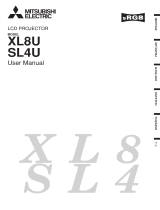
EN-5
ENGLISH
WARNING:
Unplug immediately if there is something wrong
with your projector.
Do not operate if smoke, strange noise or odor comes out of
your projector. It may cause fire or electric shock. In this case,
unplug immediately and contact your dealer.
Never remove the cabinet.
This projector contains high voltage circuitry. An inadvertent
contact may result in an electric shock. Except as specifically
explained in User Manual, do not attempt to service this prod-
uct by yourself. Please contact your dealer when you want to
fix, adjust, or inspect the projector.
Do not modify the projector.
It can lead to fire or electric shock.
Do not keep using the damaged projector.
If the projector is dropped and the cabinet is damaged, unplug
the projector and contact your dealer for inspection. It may
lead to fire if you keep using the damaged projector.
Do not face the projection lens to the sun.
It can lead to fire.
Use correct voltage.
If you use incorrect voltage, it can lead to fire.
Do not place the projector on uneven surface.
Place the projector on a level and stable surface only.
Do not look into the lens when the projector is oper-
ating.
It may hurt your eyes. Never let children look into the lens
when the projector is on.
Do not unplug the power cord during operation.
It can lead to lamp breakage, fire, electric shock or other trou-
ble. Wait for the fan to stop before unplugging the power cord.
Do not touch the air outlet grilles and bottom plate.
Do not touch them or put other equipment close to the air out-
let grilles because they become hot during operation. The
heated air outlet grilles and bottom plate may cause injury or
damage to other equipment. Also, do not put the projector on a
desk that is easily affected by heat.
Do not look into the air outlet grilles when projector
is operating.
Heat, dust, etc. may blow out of them and hurt your eyes.
Do not block the air inlet and outlet grilles.
If they are blocked, heat may be generated inside the projector,
causing deterioration in the projector quality and fire.
Place of installation
For safety’s sake, do not use the projector at any place sub-
jected to high temperature and high humidity. Please maintain
an operating temperature, humidity, and altitude as specified
below.
• Operating temperature: between +41°F (+5°C) and +95°F
(+35°C)
• Operating humidity: between 30% and 90%
• Never put any heat-producing device under the projector to
prevent the projector from being overheated.
• Do not install the projector at a place that is unstable or sub-
ject to vibration.
• Do not install the projector near any equipment that pro-
duces a strong magnetic field. Also refrain from installing
the projector near any cable carrying a large amount of cur-
rent.
• Place the projector on a solid, vibration-free surface. Other-
wise it may fall, causing serious injury or damage.
• Do not stand the projector on its end. It may fall, causing
serious injury or damage.
• Slanting the projector more than ±10° (right and left) or ±15°
(front and rear) may cause trouble or explosion of the lamp.
• Do not place the projector near air-conditioning unit or
heater to avoid the air outlet and inlet grilles from being
exposed to hot air.
COMPLIANCE NOTICE OF FCC
This equipment has been tested and found to comply with the limits for a Class B digital device, pursuant to Part 15 of the FCC
Rules. These limits are designed to provide reasonable protection against harmful interference in a residential installation. This
equipment generates, uses and can radiate radio frequency energy and, if not installed and used in accordance with the instruc-
tions, may cause harmful interference to radio communications. However, there is no guarantee that interference will not occur in
a particular installation. If this equipment does cause harmful interference to radio or television reception, which can be deter-
mined by turning the equipment off and on, the user is encouraged to try to correct the interference by one or more of the following
measures:
• Reorient or relocate the receiving antenna.
• Increase the separation between the equipment and receiver.
• Connect the equipment into an outlet on a circuit different from that to which the receiver is connected.
• Consult the dealer or an experienced Radio / TV technician for help.
Changes or modifications not expressly approved by Mitsubishi could void the user’s authority to operate this equipment.
COMPLIANCE NOTICE OF INDUSTRY CANADA
This Class B digital apparatus complies with Canadian ICES-003.





















